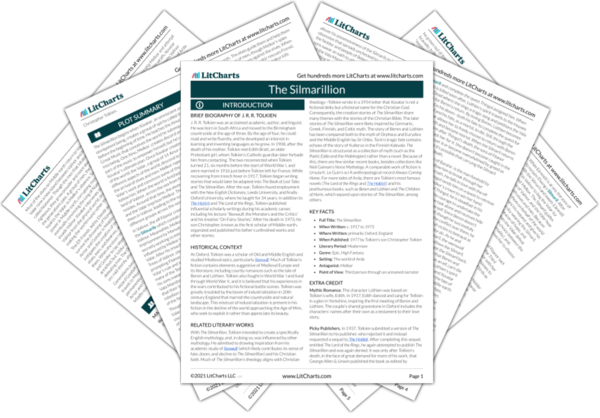In The Silmarillion, light, which takes many forms, symbolizes beauty, reason, hope, and creativity. Light appears first as the Flame Imperishable, the part of Ilúvatar’s power that gives life, brings things into being, and forms the heart of the world. The Flame Imperishable is divine light (reminiscent of the biblical Holy Spirit, which sometimes appears as flame), and all light created afterwards by the Valar has a symbolic connection to Ilúvatar, mirroring his goodness and creative power. Light is also found in the two Lamps created by the Valar, which foster the growth of the plants and animals on Middle-earth. That light is destroyed, however, when Melkor breaks the Lamps and their fire rages across the Isle of Almaren. Melkor’s destructive fire—such as the sacrificial fire of his altar in Númenor and his fire spirit servants the Balrogs—complicates light as a symbol and corrupts it into a distorted parody of the Flame Imperishable.
After the destruction of the Lamps, Yavanna grows the Two Trees of Valinor, which produce living light untouched by evil. The Silmarillion also mentions something called the Light of Valinor, which refers both to the unsullied light of the Trees and the reason and righteousness of its inhabitants. The Light of Valinor can spread from the inhabitants of Valinor to the people of Middle-earth and is visible in the faces of those who embody Valinor’s goodness, beauty, and wisdom. While the Trees provide light for Valinor, Middle-earth is lit only by the stars, created by Varda and sacred to the elves. Later, the Star of Eärendil, one of the Silmarils that also contain the light of the Trees, becomes a sign of hope and a guiding light for the people of Middle-earth. Though the Silmarils are bitterly fought over, the beauty of the Star of Eärendil is shared by all. After Melkor and Ungoliant destroy the Trees and send the world into darkness, the Valar create the sun and moon from the remnants of the Trees to brighten Middle-earth and frighten Melkor into hiding.
Light Quotes in The Silmarillion
Never since have the Ainur made any music like to this music, though it has been said that a greater still shall be made before Ilúvatar by the choirs of the Ainur and the Children of Ilúvatar after the end of days. Then the themes of Ilúvatar shall be played aright, and take Being in the moment of their utterance, for all shall then understand fully his intent in their part, and each shall know the comprehension of each, and Ilúvatar shall give to their thoughts the secret fire, being well pleased.

Unlock explanations and citation info for this and every other The Silmarillion quote.
Plus so much more...
Get LitCharts A+Thus ere the Valar were aware, the peace of Valinor was poisoned. The Noldor began to murmur against them, and many became filled with pride, forgetting how much of what they had and knew came to them in gift from the Valar. Fiercest burned the new flame of desire for freedom and wider realms in the eager heart of Fëanor; and Melkor laughed in his secrecy, for to that mark his lies had been addressed, hating Fëanor above all, and lusting ever for the Silmarils. But these he was not suffered to approach […] for Fëanor began to love the Silmarils with a greedy love, and grudged the sight of them to all save to his father and his seven sons; he seldom remembered now that the light within them was not his own.
Then perforce Morgoth surrendered to her the gems that he bore with him, one by one and grudgingly; and she devoured them, and their beauty perished from the world. Huger and darker yet grew Ungoliant, but her lust was unsated. ‘With one hand thou givest,’ she said; ‘with the left only. Open thy right hand.’
In his right hand Morgoth held close the Silmarils, and though they were locked in a crystal casket, they had begun to burn him, and his hand was clenched in pain; but he would not open it. ‘Nay!’ he said. ‘Thou has had thy due. For with my power that I put into thee thy work was accomplished. I need thee no more. These things thou shalt not have, nor see. I name them unto myself for ever.’
Farewell sweet earth and northern sky
for ever blest, since here did lie
and here with lissome limbs did run
beneath the Moon, beneath the Sun,
Lúthien Tinúviel
more fair than mortal tongue can tell.
Though all to ruin fell the world
and were dissolved and backward hurled
unmade into the old abyss,
yet were its making good, for this—
the dusk, the dawn, the earth, the sea—
that Lúthien for a time should be.
Thus was the treachery of Uldor redressed; and of all the deeds of war that the fathers of Men wrought in behalf of the Eldar, the last stand of the Men of Dor-lómin is most renowned.
[…]
Last of all Húrin stood alone. Then he cast aside his shield, and wielded an axe two-handed; and it is sung that the axe smoked in the black blood of the troll-guard of Gothmog until it withered, and each time that he slew Húrin cried: ‘Aurë entuluva! Day shall come again!’
‘If it be truly the Silmaril which we saw cast into the sea that rises again by the power of the Valar, then let us be glad; for its glory is seen now by many, and is yet secure from all evil.’ Then the Elves looked up, and despaired no longer; but Morgoth was filled with doubt.












